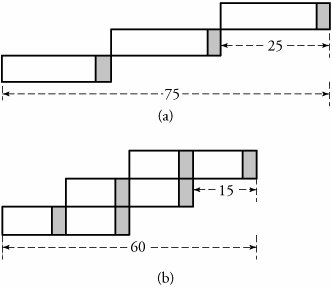Section 1.3. Packet Size and Optimizations
1.3. Packet Size and OptimizationsPacket size has a substantial impact on the performance of data transmission. Consider Figure 1.9, which compares the transmission of a 60-byte message using two different packet sizes with a packet header of 5 bytes. In the first scheme, the message is fragmented into three pieces of 20 bytes each, resulting in three packets of 25 bytes each. If these three packets are supposed to be transmitted over path A, D, C, and B in Figure 1.6, 75-byte units of delay are required. In contrast, if the message is fragmented into six messages of 10 bytes each, resulting in 15-byte packets, the total delay would be 60-byte units of delay. The reason for the time reduction is the parallel transmission of multiple packets at nodes D and C, since packets are smaller. This trend of delay reduction using smaller packets, however, is reversed at a certain point, owing to the dominance of packet overhead when a packet becomes very small. Figure 1.9. Comparison of two cases of transmitting data: (a) using three packets and (b) using six packets To analyze packet size optimization, consider a link with a speed of s b/s or a bit rate of ¼ packets per second. Assume that packets of size d + h are sent over this link at the rate » packets per second, where d and h are the sizes of the packet data and the packet header, respectively, in bits. Clearly, Equation 1.3 We define link utilization to be = »/¼ . Then the percentage of link utilization used by data, d , is obtained by Equation 1.4 The average delay per packet, D , can be calculated by using ¼ - » , where this term exhibits how close the offered load is to the link capacity: Equation 1.5 Using equations (1.3) and (1.4), we can rewrite the average delay per packet as Equation 1.6 Apparently, the optimum size of a packet depends on several contributing factors. Here, we examine one of the factors by which the delay and the packet size become optimum. For optimality, consider d as one possible variable, where we want Equation 1.7 This releases the two optimum values: Equation 1.8 and Equation 1.9 Note that here, d and D are optimized given only the mentioned variables . The optimality of d and D can also be derived by using a number of other factors that will result in a more accurate approach. |
EAN: 2147483647
Pages: 211
